CIS 500: Proposal of Enterprise Information System Implementation
VerifiedAdded on 2022/11/23
|9
|1882
|112
Project
AI Summary
This project proposal, submitted by a student, outlines a comprehensive plan for implementing an enterprise information system. The proposal begins with an introduction highlighting the need for a new system to address the shortcomings of the existing one, particularly the rise of shadow IT projects. It details the functionalities of the proposed system, including data input, processing, storage, and output, emphasizing its open system nature and interactions with both internal members and external customers. The proposal then delves into data management aspects, specifying data types, storage methods, and data quality measures. It also explains the transition process from the old system to the new one, including feedback loops. The project also includes weekly status reports for weeks 8 and 9, which detail the planned and actual accomplishments, issues encountered, and next steps. The proposal also includes a presentation addressing goals, success factors, acquisition strategy, resources, system functions, and connectivity. The goal is to provide a robust, interconnected system that can gather and process data to aid business activities and support analytics. The project concludes by referencing supporting literature.
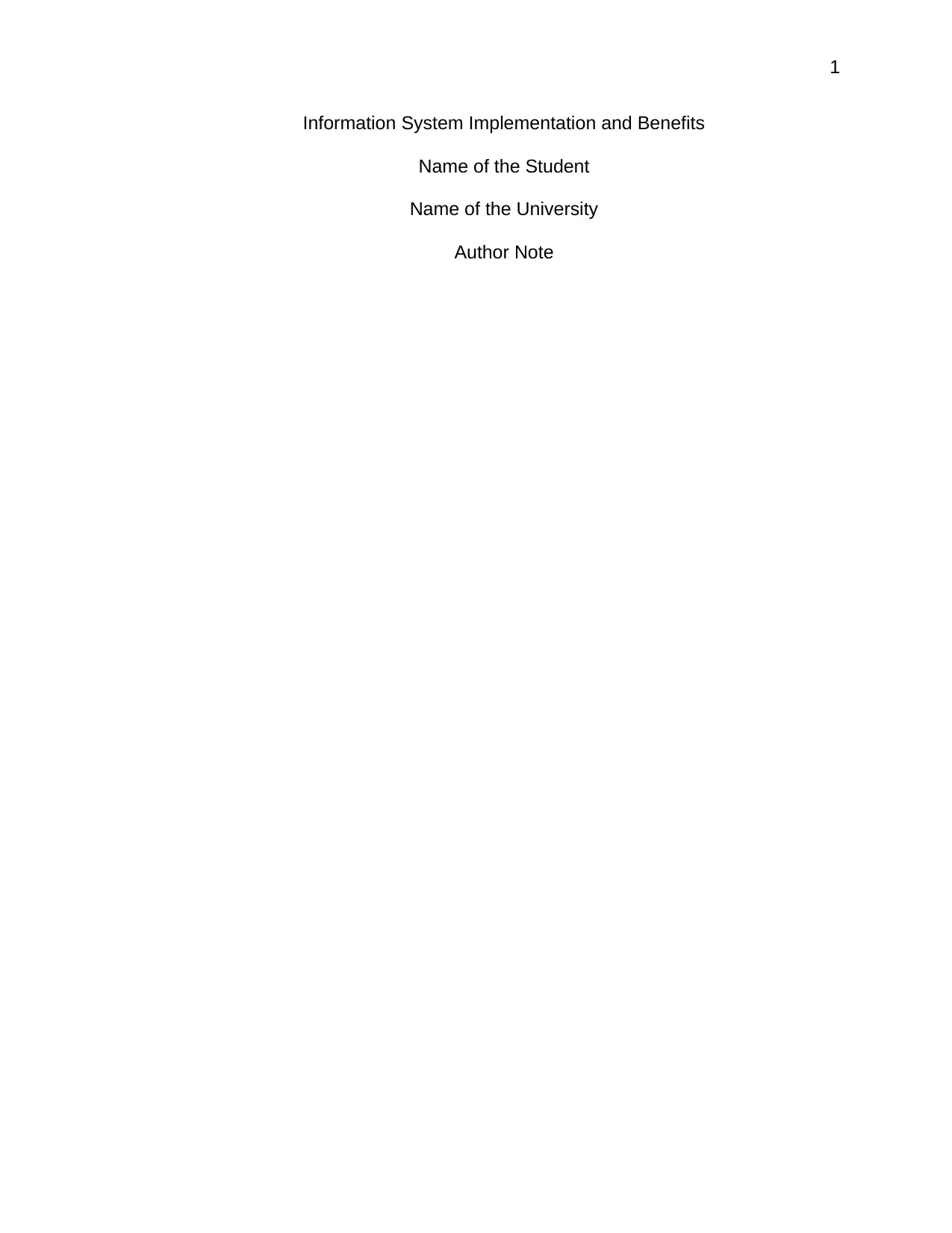
1
Information System Implementation and Benefits
Name of the Student
Name of the University
Author Note
Information System Implementation and Benefits
Name of the Student
Name of the University
Author Note
Paraphrase This Document
Need a fresh take? Get an instant paraphrase of this document with our AI Paraphraser
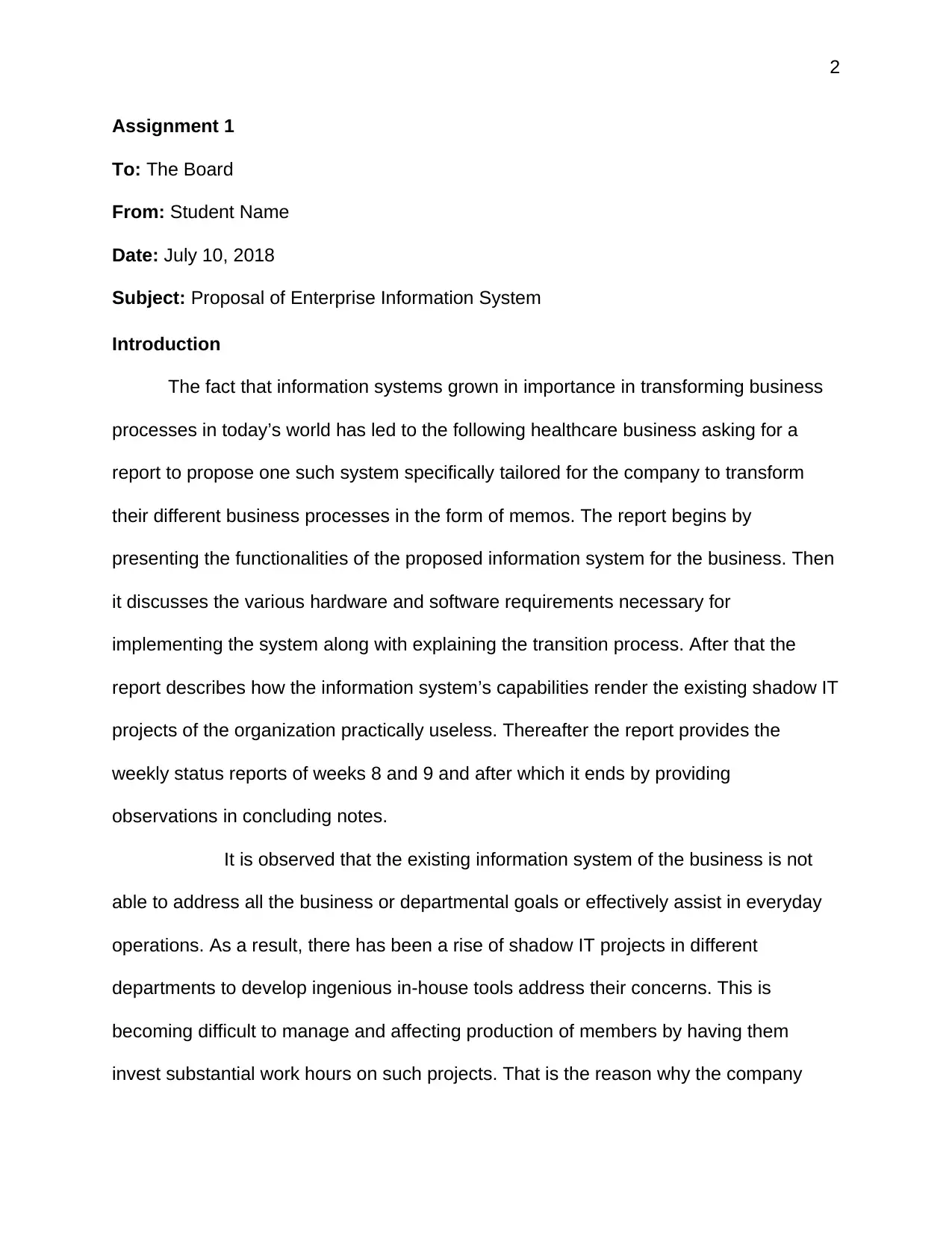
2
Assignment 1
To: The Board
From: Student Name
Date: July 10, 2018
Subject: Proposal of Enterprise Information System
Introduction
The fact that information systems grown in importance in transforming business
processes in today’s world has led to the following healthcare business asking for a
report to propose one such system specifically tailored for the company to transform
their different business processes in the form of memos. The report begins by
presenting the functionalities of the proposed information system for the business. Then
it discusses the various hardware and software requirements necessary for
implementing the system along with explaining the transition process. After that the
report describes how the information system’s capabilities render the existing shadow IT
projects of the organization practically useless. Thereafter the report provides the
weekly status reports of weeks 8 and 9 and after which it ends by providing
observations in concluding notes.
It is observed that the existing information system of the business is not
able to address all the business or departmental goals or effectively assist in everyday
operations. As a result, there has been a rise of shadow IT projects in different
departments to develop ingenious in-house tools address their concerns. This is
becoming difficult to manage and affecting production of members by having them
invest substantial work hours on such projects. That is the reason why the company
Assignment 1
To: The Board
From: Student Name
Date: July 10, 2018
Subject: Proposal of Enterprise Information System
Introduction
The fact that information systems grown in importance in transforming business
processes in today’s world has led to the following healthcare business asking for a
report to propose one such system specifically tailored for the company to transform
their different business processes in the form of memos. The report begins by
presenting the functionalities of the proposed information system for the business. Then
it discusses the various hardware and software requirements necessary for
implementing the system along with explaining the transition process. After that the
report describes how the information system’s capabilities render the existing shadow IT
projects of the organization practically useless. Thereafter the report provides the
weekly status reports of weeks 8 and 9 and after which it ends by providing
observations in concluding notes.
It is observed that the existing information system of the business is not
able to address all the business or departmental goals or effectively assist in everyday
operations. As a result, there has been a rise of shadow IT projects in different
departments to develop ingenious in-house tools address their concerns. This is
becoming difficult to manage and affecting production of members by having them
invest substantial work hours on such projects. That is the reason why the company
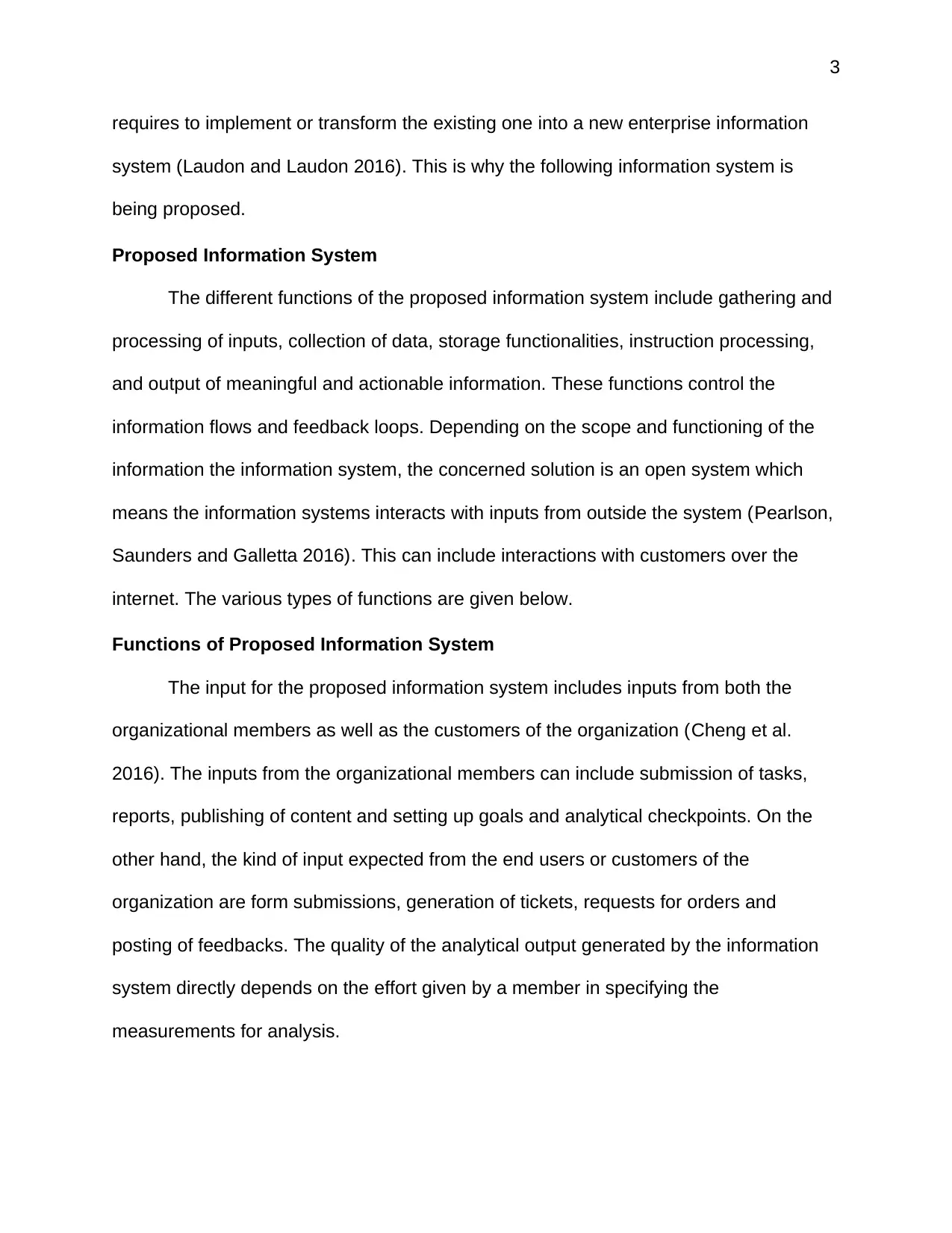
3
requires to implement or transform the existing one into a new enterprise information
system (Laudon and Laudon 2016). This is why the following information system is
being proposed.
Proposed Information System
The different functions of the proposed information system include gathering and
processing of inputs, collection of data, storage functionalities, instruction processing,
and output of meaningful and actionable information. These functions control the
information flows and feedback loops. Depending on the scope and functioning of the
information the information system, the concerned solution is an open system which
means the information systems interacts with inputs from outside the system (Pearlson,
Saunders and Galletta 2016). This can include interactions with customers over the
internet. The various types of functions are given below.
Functions of Proposed Information System
The input for the proposed information system includes inputs from both the
organizational members as well as the customers of the organization (Cheng et al.
2016). The inputs from the organizational members can include submission of tasks,
reports, publishing of content and setting up goals and analytical checkpoints. On the
other hand, the kind of input expected from the end users or customers of the
organization are form submissions, generation of tickets, requests for orders and
posting of feedbacks. The quality of the analytical output generated by the information
system directly depends on the effort given by a member in specifying the
measurements for analysis.
requires to implement or transform the existing one into a new enterprise information
system (Laudon and Laudon 2016). This is why the following information system is
being proposed.
Proposed Information System
The different functions of the proposed information system include gathering and
processing of inputs, collection of data, storage functionalities, instruction processing,
and output of meaningful and actionable information. These functions control the
information flows and feedback loops. Depending on the scope and functioning of the
information the information system, the concerned solution is an open system which
means the information systems interacts with inputs from outside the system (Pearlson,
Saunders and Galletta 2016). This can include interactions with customers over the
internet. The various types of functions are given below.
Functions of Proposed Information System
The input for the proposed information system includes inputs from both the
organizational members as well as the customers of the organization (Cheng et al.
2016). The inputs from the organizational members can include submission of tasks,
reports, publishing of content and setting up goals and analytical checkpoints. On the
other hand, the kind of input expected from the end users or customers of the
organization are form submissions, generation of tickets, requests for orders and
posting of feedbacks. The quality of the analytical output generated by the information
system directly depends on the effort given by a member in specifying the
measurements for analysis.
⊘ This is a preview!⊘
Do you want full access?
Subscribe today to unlock all pages.

Trusted by 1+ million students worldwide
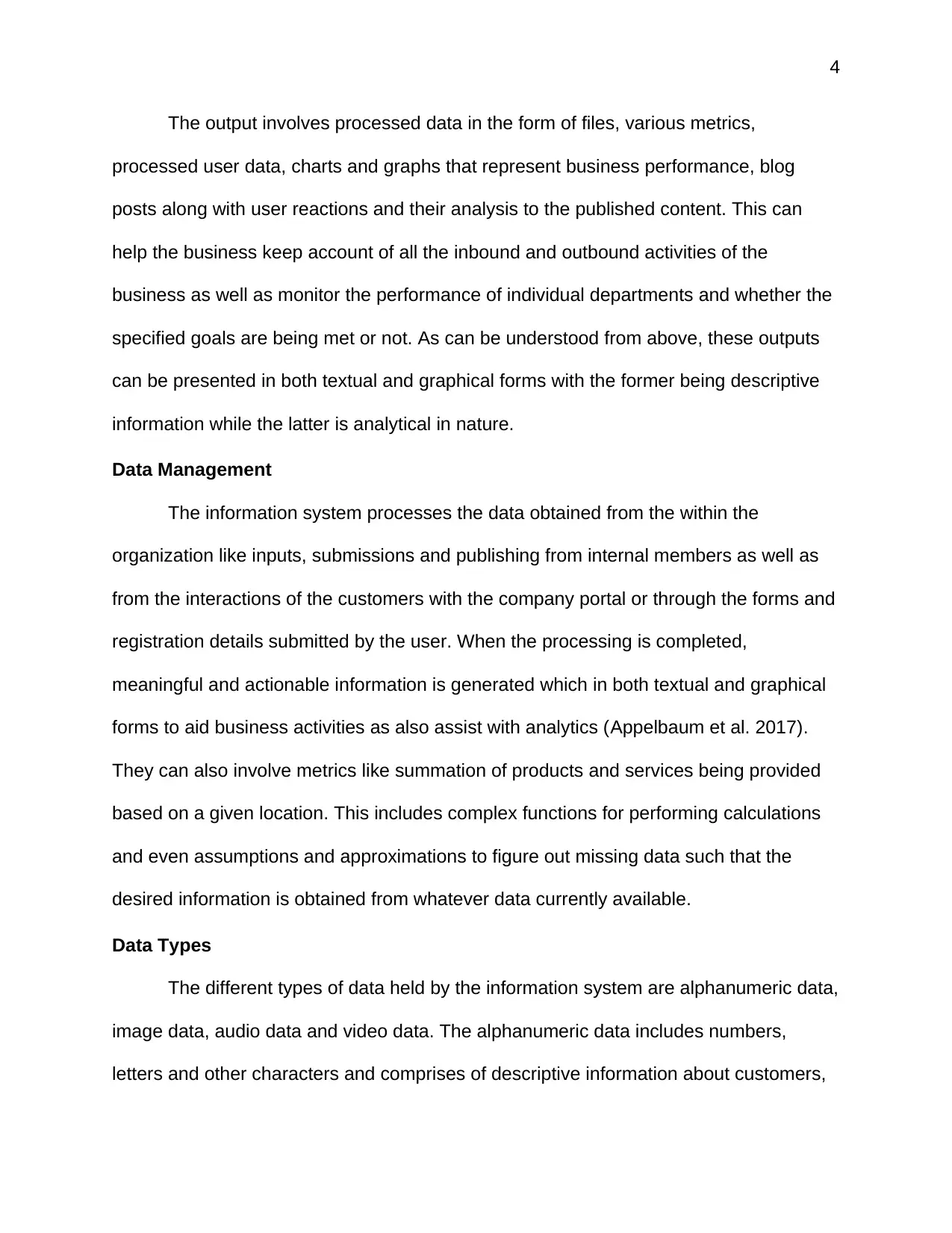
4
The output involves processed data in the form of files, various metrics,
processed user data, charts and graphs that represent business performance, blog
posts along with user reactions and their analysis to the published content. This can
help the business keep account of all the inbound and outbound activities of the
business as well as monitor the performance of individual departments and whether the
specified goals are being met or not. As can be understood from above, these outputs
can be presented in both textual and graphical forms with the former being descriptive
information while the latter is analytical in nature.
Data Management
The information system processes the data obtained from the within the
organization like inputs, submissions and publishing from internal members as well as
from the interactions of the customers with the company portal or through the forms and
registration details submitted by the user. When the processing is completed,
meaningful and actionable information is generated which in both textual and graphical
forms to aid business activities as also assist with analytics (Appelbaum et al. 2017).
They can also involve metrics like summation of products and services being provided
based on a given location. This includes complex functions for performing calculations
and even assumptions and approximations to figure out missing data such that the
desired information is obtained from whatever data currently available.
Data Types
The different types of data held by the information system are alphanumeric data,
image data, audio data and video data. The alphanumeric data includes numbers,
letters and other characters and comprises of descriptive information about customers,
The output involves processed data in the form of files, various metrics,
processed user data, charts and graphs that represent business performance, blog
posts along with user reactions and their analysis to the published content. This can
help the business keep account of all the inbound and outbound activities of the
business as well as monitor the performance of individual departments and whether the
specified goals are being met or not. As can be understood from above, these outputs
can be presented in both textual and graphical forms with the former being descriptive
information while the latter is analytical in nature.
Data Management
The information system processes the data obtained from the within the
organization like inputs, submissions and publishing from internal members as well as
from the interactions of the customers with the company portal or through the forms and
registration details submitted by the user. When the processing is completed,
meaningful and actionable information is generated which in both textual and graphical
forms to aid business activities as also assist with analytics (Appelbaum et al. 2017).
They can also involve metrics like summation of products and services being provided
based on a given location. This includes complex functions for performing calculations
and even assumptions and approximations to figure out missing data such that the
desired information is obtained from whatever data currently available.
Data Types
The different types of data held by the information system are alphanumeric data,
image data, audio data and video data. The alphanumeric data includes numbers,
letters and other characters and comprises of descriptive information about customers,
Paraphrase This Document
Need a fresh take? Get an instant paraphrase of this document with our AI Paraphraser
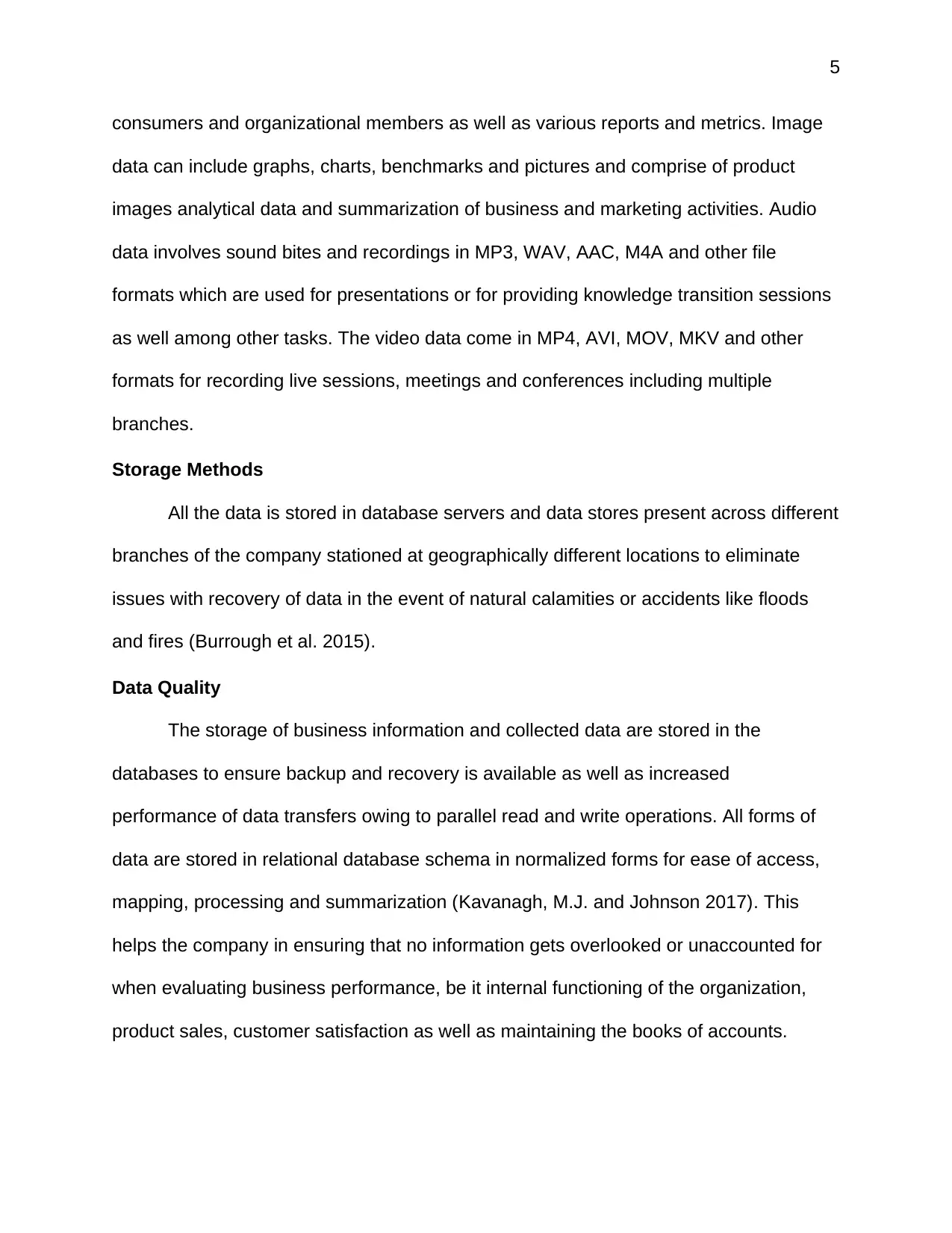
5
consumers and organizational members as well as various reports and metrics. Image
data can include graphs, charts, benchmarks and pictures and comprise of product
images analytical data and summarization of business and marketing activities. Audio
data involves sound bites and recordings in MP3, WAV, AAC, M4A and other file
formats which are used for presentations or for providing knowledge transition sessions
as well among other tasks. The video data come in MP4, AVI, MOV, MKV and other
formats for recording live sessions, meetings and conferences including multiple
branches.
Storage Methods
All the data is stored in database servers and data stores present across different
branches of the company stationed at geographically different locations to eliminate
issues with recovery of data in the event of natural calamities or accidents like floods
and fires (Burrough et al. 2015).
Data Quality
The storage of business information and collected data are stored in the
databases to ensure backup and recovery is available as well as increased
performance of data transfers owing to parallel read and write operations. All forms of
data are stored in relational database schema in normalized forms for ease of access,
mapping, processing and summarization (Kavanagh, M.J. and Johnson 2017). This
helps the company in ensuring that no information gets overlooked or unaccounted for
when evaluating business performance, be it internal functioning of the organization,
product sales, customer satisfaction as well as maintaining the books of accounts.
consumers and organizational members as well as various reports and metrics. Image
data can include graphs, charts, benchmarks and pictures and comprise of product
images analytical data and summarization of business and marketing activities. Audio
data involves sound bites and recordings in MP3, WAV, AAC, M4A and other file
formats which are used for presentations or for providing knowledge transition sessions
as well among other tasks. The video data come in MP4, AVI, MOV, MKV and other
formats for recording live sessions, meetings and conferences including multiple
branches.
Storage Methods
All the data is stored in database servers and data stores present across different
branches of the company stationed at geographically different locations to eliminate
issues with recovery of data in the event of natural calamities or accidents like floods
and fires (Burrough et al. 2015).
Data Quality
The storage of business information and collected data are stored in the
databases to ensure backup and recovery is available as well as increased
performance of data transfers owing to parallel read and write operations. All forms of
data are stored in relational database schema in normalized forms for ease of access,
mapping, processing and summarization (Kavanagh, M.J. and Johnson 2017). This
helps the company in ensuring that no information gets overlooked or unaccounted for
when evaluating business performance, be it internal functioning of the organization,
product sales, customer satisfaction as well as maintaining the books of accounts.
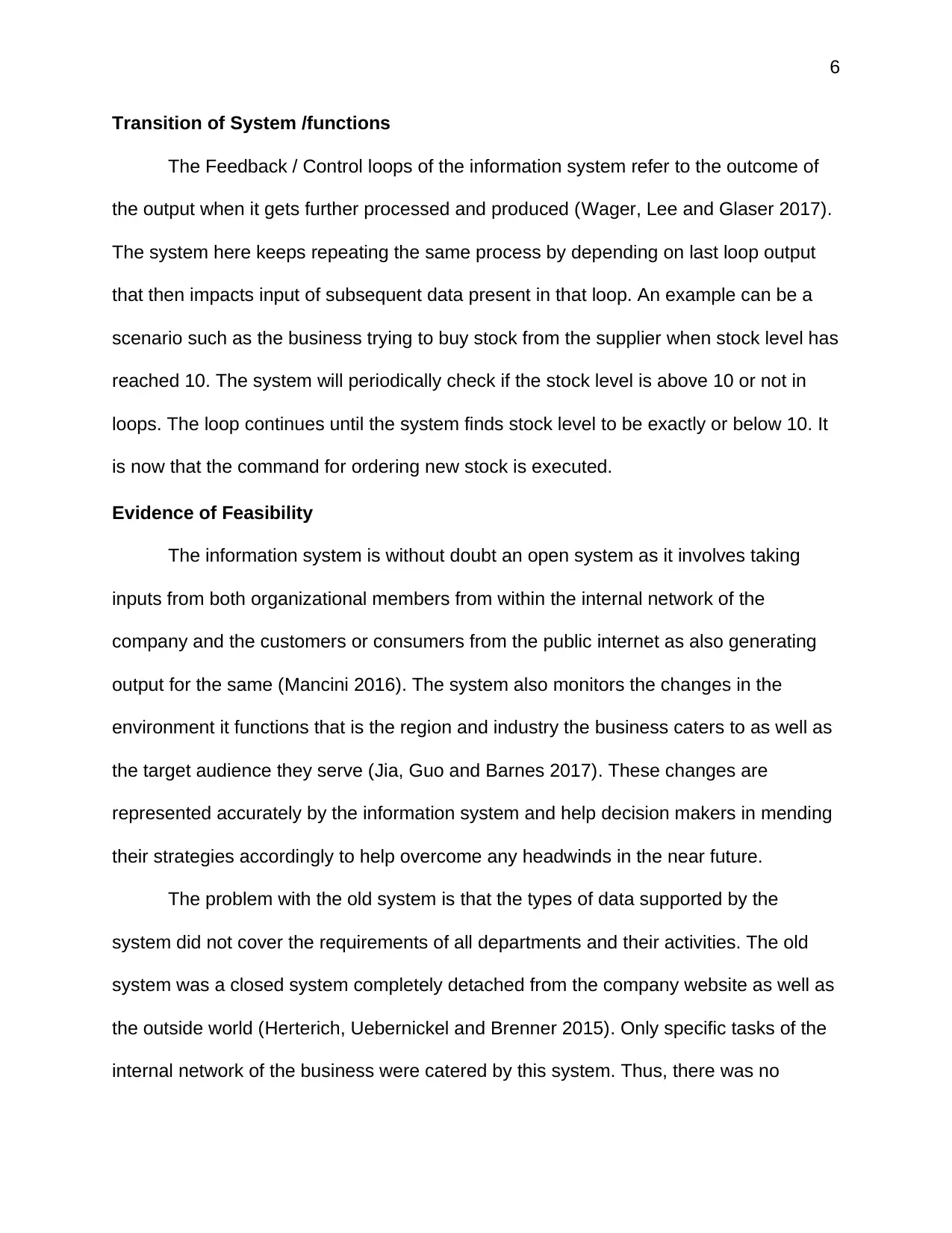
6
Transition of System /functions
The Feedback / Control loops of the information system refer to the outcome of
the output when it gets further processed and produced (Wager, Lee and Glaser 2017).
The system here keeps repeating the same process by depending on last loop output
that then impacts input of subsequent data present in that loop. An example can be a
scenario such as the business trying to buy stock from the supplier when stock level has
reached 10. The system will periodically check if the stock level is above 10 or not in
loops. The loop continues until the system finds stock level to be exactly or below 10. It
is now that the command for ordering new stock is executed.
Evidence of Feasibility
The information system is without doubt an open system as it involves taking
inputs from both organizational members from within the internal network of the
company and the customers or consumers from the public internet as also generating
output for the same (Mancini 2016). The system also monitors the changes in the
environment it functions that is the region and industry the business caters to as well as
the target audience they serve (Jia, Guo and Barnes 2017). These changes are
represented accurately by the information system and help decision makers in mending
their strategies accordingly to help overcome any headwinds in the near future.
The problem with the old system is that the types of data supported by the
system did not cover the requirements of all departments and their activities. The old
system was a closed system completely detached from the company website as well as
the outside world (Herterich, Uebernickel and Brenner 2015). Only specific tasks of the
internal network of the business were catered by this system. Thus, there was no
Transition of System /functions
The Feedback / Control loops of the information system refer to the outcome of
the output when it gets further processed and produced (Wager, Lee and Glaser 2017).
The system here keeps repeating the same process by depending on last loop output
that then impacts input of subsequent data present in that loop. An example can be a
scenario such as the business trying to buy stock from the supplier when stock level has
reached 10. The system will periodically check if the stock level is above 10 or not in
loops. The loop continues until the system finds stock level to be exactly or below 10. It
is now that the command for ordering new stock is executed.
Evidence of Feasibility
The information system is without doubt an open system as it involves taking
inputs from both organizational members from within the internal network of the
company and the customers or consumers from the public internet as also generating
output for the same (Mancini 2016). The system also monitors the changes in the
environment it functions that is the region and industry the business caters to as well as
the target audience they serve (Jia, Guo and Barnes 2017). These changes are
represented accurately by the information system and help decision makers in mending
their strategies accordingly to help overcome any headwinds in the near future.
The problem with the old system is that the types of data supported by the
system did not cover the requirements of all departments and their activities. The old
system was a closed system completely detached from the company website as well as
the outside world (Herterich, Uebernickel and Brenner 2015). Only specific tasks of the
internal network of the business were catered by this system. Thus, there was no
⊘ This is a preview!⊘
Do you want full access?
Subscribe today to unlock all pages.

Trusted by 1+ million students worldwide
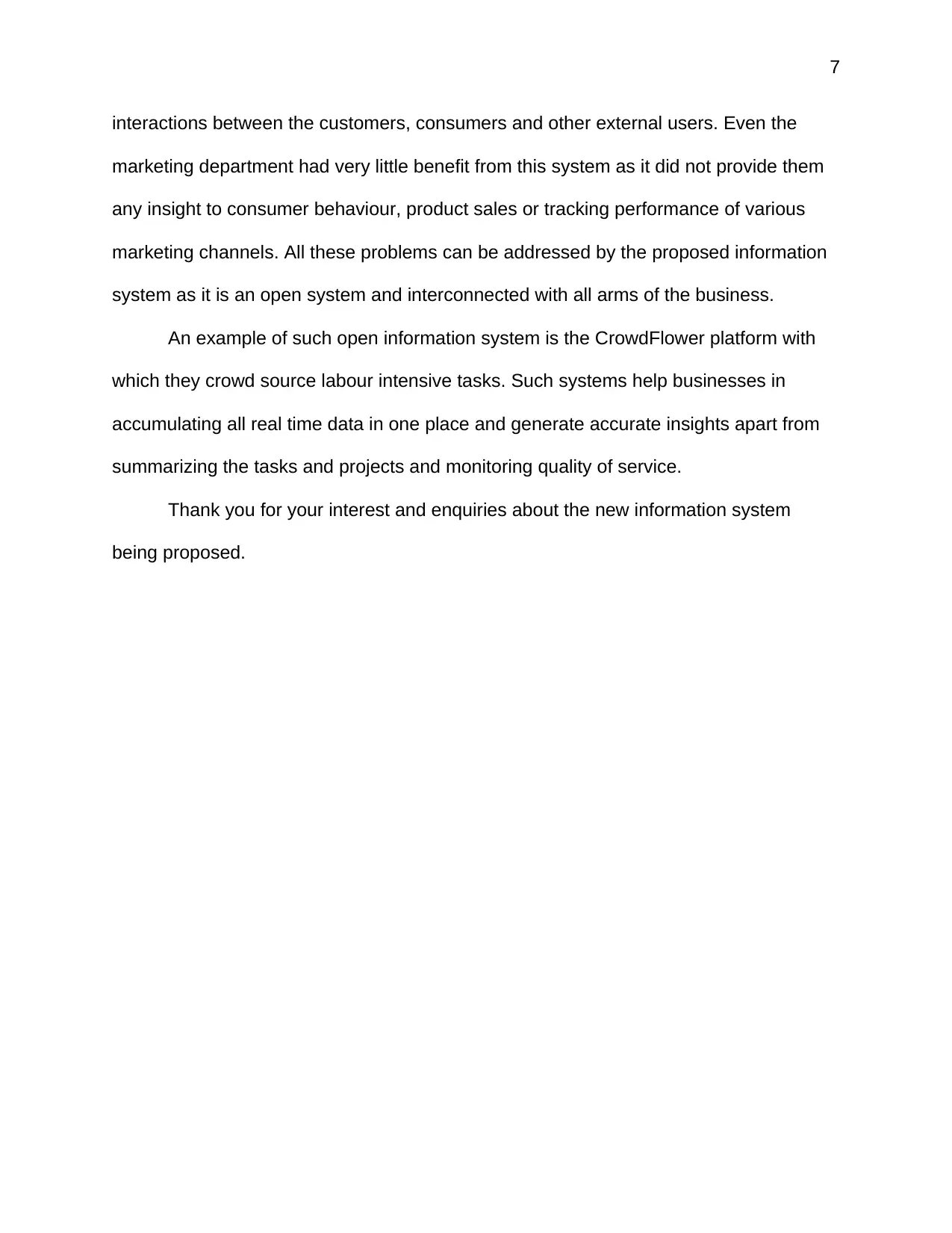
7
interactions between the customers, consumers and other external users. Even the
marketing department had very little benefit from this system as it did not provide them
any insight to consumer behaviour, product sales or tracking performance of various
marketing channels. All these problems can be addressed by the proposed information
system as it is an open system and interconnected with all arms of the business.
An example of such open information system is the CrowdFlower platform with
which they crowd source labour intensive tasks. Such systems help businesses in
accumulating all real time data in one place and generate accurate insights apart from
summarizing the tasks and projects and monitoring quality of service.
Thank you for your interest and enquiries about the new information system
being proposed.
interactions between the customers, consumers and other external users. Even the
marketing department had very little benefit from this system as it did not provide them
any insight to consumer behaviour, product sales or tracking performance of various
marketing channels. All these problems can be addressed by the proposed information
system as it is an open system and interconnected with all arms of the business.
An example of such open information system is the CrowdFlower platform with
which they crowd source labour intensive tasks. Such systems help businesses in
accumulating all real time data in one place and generate accurate insights apart from
summarizing the tasks and projects and monitoring quality of service.
Thank you for your interest and enquiries about the new information system
being proposed.
Paraphrase This Document
Need a fresh take? Get an instant paraphrase of this document with our AI Paraphraser
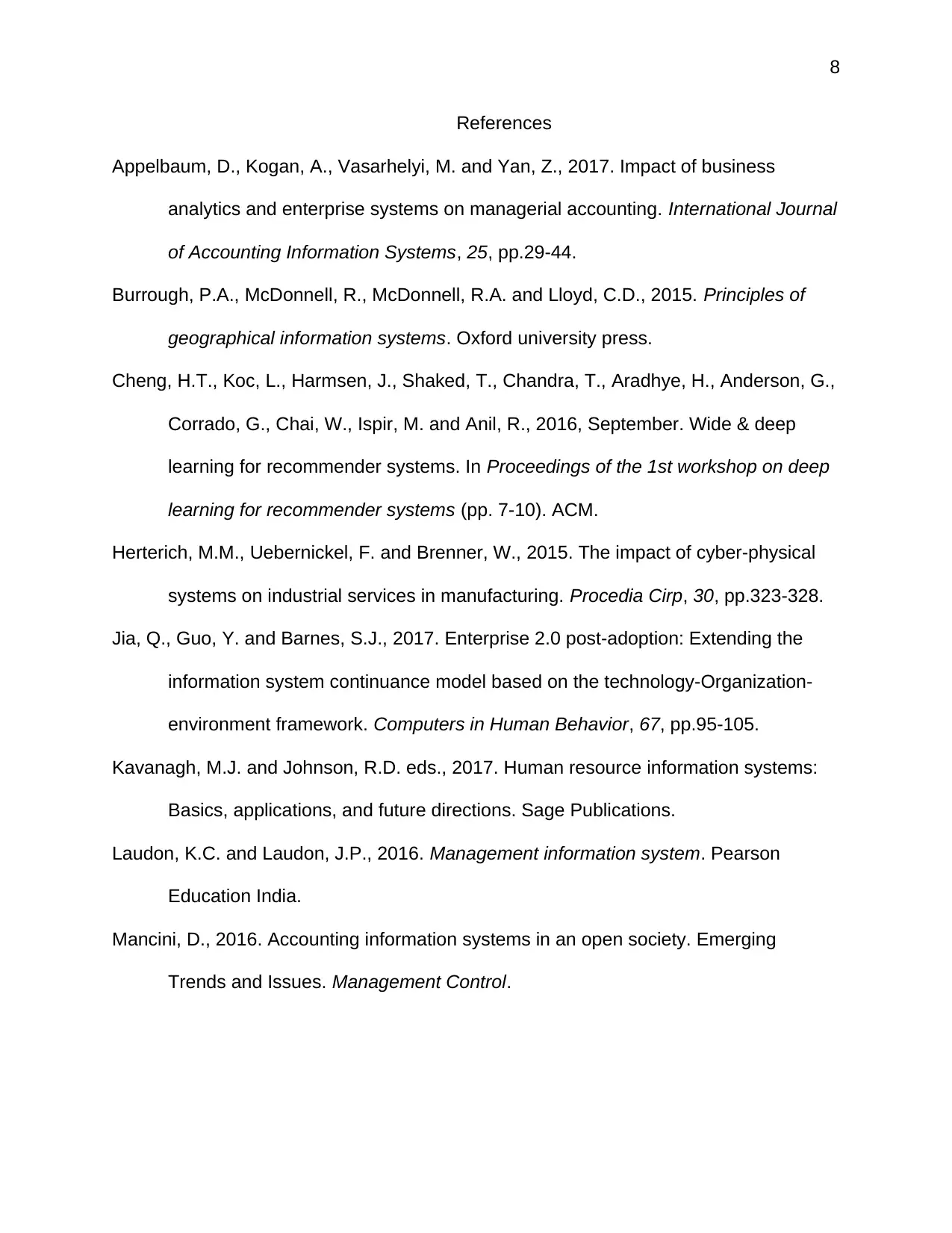
8
References
Appelbaum, D., Kogan, A., Vasarhelyi, M. and Yan, Z., 2017. Impact of business
analytics and enterprise systems on managerial accounting. International Journal
of Accounting Information Systems, 25, pp.29-44.
Burrough, P.A., McDonnell, R., McDonnell, R.A. and Lloyd, C.D., 2015. Principles of
geographical information systems. Oxford university press.
Cheng, H.T., Koc, L., Harmsen, J., Shaked, T., Chandra, T., Aradhye, H., Anderson, G.,
Corrado, G., Chai, W., Ispir, M. and Anil, R., 2016, September. Wide & deep
learning for recommender systems. In Proceedings of the 1st workshop on deep
learning for recommender systems (pp. 7-10). ACM.
Herterich, M.M., Uebernickel, F. and Brenner, W., 2015. The impact of cyber-physical
systems on industrial services in manufacturing. Procedia Cirp, 30, pp.323-328.
Jia, Q., Guo, Y. and Barnes, S.J., 2017. Enterprise 2.0 post-adoption: Extending the
information system continuance model based on the technology-Organization-
environment framework. Computers in Human Behavior, 67, pp.95-105.
Kavanagh, M.J. and Johnson, R.D. eds., 2017. Human resource information systems:
Basics, applications, and future directions. Sage Publications.
Laudon, K.C. and Laudon, J.P., 2016. Management information system. Pearson
Education India.
Mancini, D., 2016. Accounting information systems in an open society. Emerging
Trends and Issues. Management Control.
References
Appelbaum, D., Kogan, A., Vasarhelyi, M. and Yan, Z., 2017. Impact of business
analytics and enterprise systems on managerial accounting. International Journal
of Accounting Information Systems, 25, pp.29-44.
Burrough, P.A., McDonnell, R., McDonnell, R.A. and Lloyd, C.D., 2015. Principles of
geographical information systems. Oxford university press.
Cheng, H.T., Koc, L., Harmsen, J., Shaked, T., Chandra, T., Aradhye, H., Anderson, G.,
Corrado, G., Chai, W., Ispir, M. and Anil, R., 2016, September. Wide & deep
learning for recommender systems. In Proceedings of the 1st workshop on deep
learning for recommender systems (pp. 7-10). ACM.
Herterich, M.M., Uebernickel, F. and Brenner, W., 2015. The impact of cyber-physical
systems on industrial services in manufacturing. Procedia Cirp, 30, pp.323-328.
Jia, Q., Guo, Y. and Barnes, S.J., 2017. Enterprise 2.0 post-adoption: Extending the
information system continuance model based on the technology-Organization-
environment framework. Computers in Human Behavior, 67, pp.95-105.
Kavanagh, M.J. and Johnson, R.D. eds., 2017. Human resource information systems:
Basics, applications, and future directions. Sage Publications.
Laudon, K.C. and Laudon, J.P., 2016. Management information system. Pearson
Education India.
Mancini, D., 2016. Accounting information systems in an open society. Emerging
Trends and Issues. Management Control.
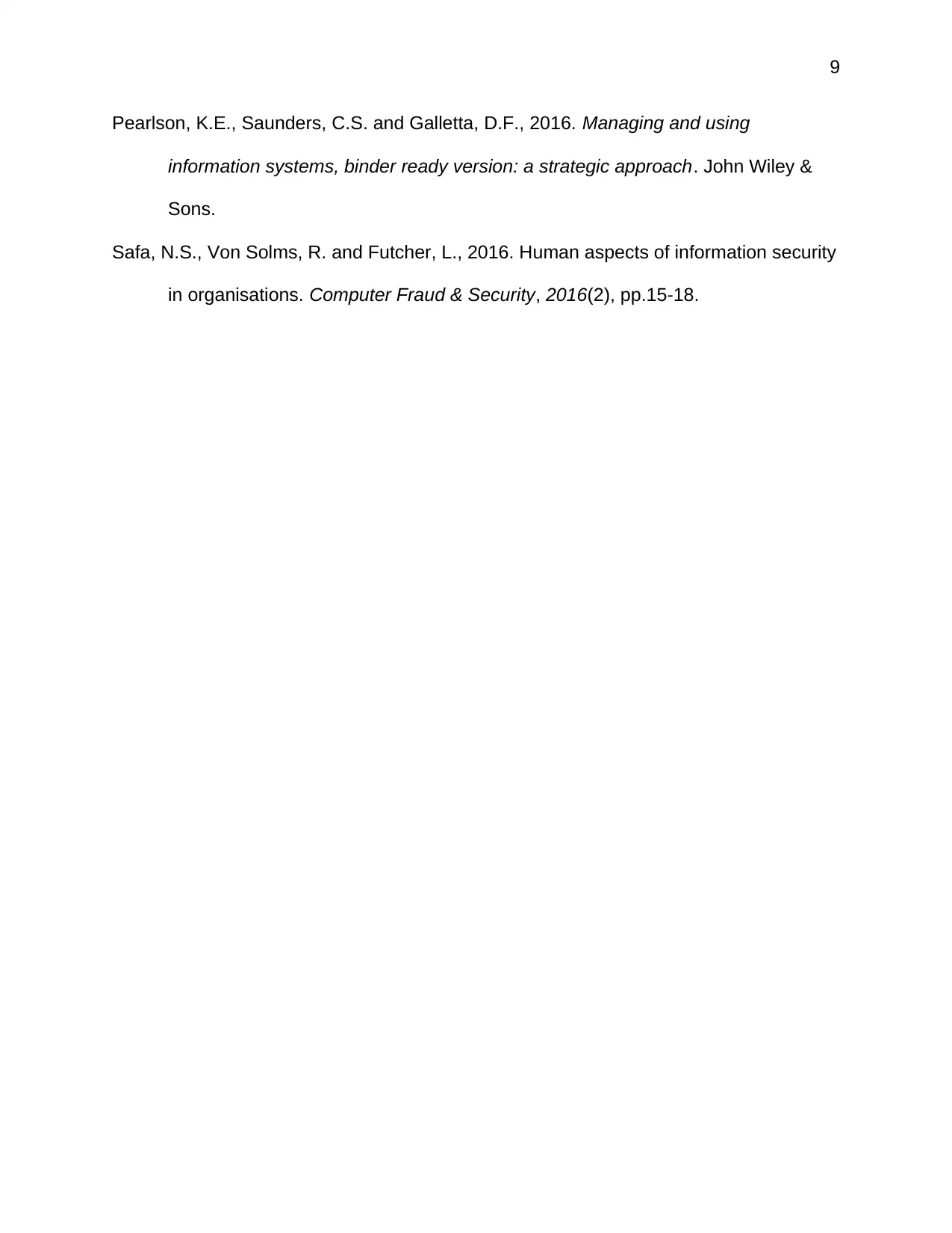
9
Pearlson, K.E., Saunders, C.S. and Galletta, D.F., 2016. Managing and using
information systems, binder ready version: a strategic approach. John Wiley &
Sons.
Safa, N.S., Von Solms, R. and Futcher, L., 2016. Human aspects of information security
in organisations. Computer Fraud & Security, 2016(2), pp.15-18.
Pearlson, K.E., Saunders, C.S. and Galletta, D.F., 2016. Managing and using
information systems, binder ready version: a strategic approach. John Wiley &
Sons.
Safa, N.S., Von Solms, R. and Futcher, L., 2016. Human aspects of information security
in organisations. Computer Fraud & Security, 2016(2), pp.15-18.
⊘ This is a preview!⊘
Do you want full access?
Subscribe today to unlock all pages.

Trusted by 1+ million students worldwide
1 out of 9
Related Documents
Your All-in-One AI-Powered Toolkit for Academic Success.
+13062052269
info@desklib.com
Available 24*7 on WhatsApp / Email
![[object Object]](/_next/static/media/star-bottom.7253800d.svg)
Unlock your academic potential
Copyright © 2020–2025 A2Z Services. All Rights Reserved. Developed and managed by ZUCOL.





